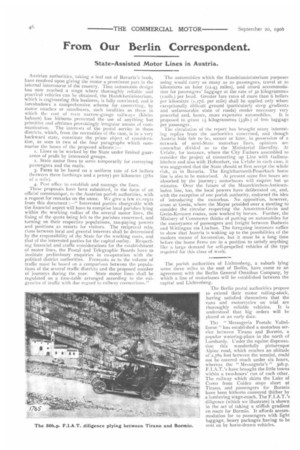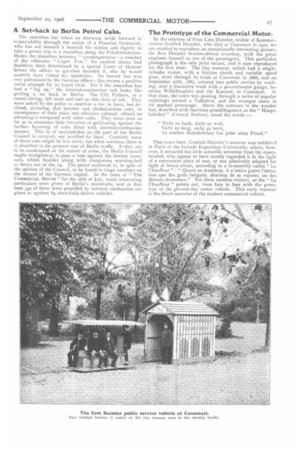From Our Berlin Correspondent.
Page 22

Page 23

If you've noticed an error in this article please click here to report it so we can fix it.
State-Assisted Motor Lines in Austria.
Austrian authorities, taking a leaf out of Bavaria's book, have resolved upon giving the motor a prominent part in the internal intercourse of the country. That automobile design has now reached a stage where thoroughly reliable and practical vehicles can be obtained, the Handuisministerium, which is engineering this business, is fully convinced, and it foreshadows a comprehensive scheme for connecting, by motor coaches or omnibuses, such localities as those in which the cost of even narrow-gauge railways (Kleinbahnen) has hitherto prevented the use of anything but primitive and ofttimes provokingly irregular means of communication. The interests of the postal service in these districts, which, from the necessities of the case, is in a very backward state, constitute the prime object of consideration, as seen in two of the four paragraphs which summarise the bases of the proposed scheme : i. Lines to be worked by the State under limited guarantee of profit by interested groups. 2. State motor lines to serve temporarily for conveying passengers and the mails.
3. Fares to be based on a uniform rate of 6-8 hellers (between three farthings and a penny) per kilometre (:ths of a mile).
4. Post other to establish and manage the lines. These proposals have been submitted, in the form of an .official communique, to the Austrian parish authorities, with a request for remarks on the same. We give a few ex:erpts from this document :—" Interested parties chargeable with the financial aspect will have to comprise local parishes lying within the working radius of the several motor lines, the fixing of the quota being left to the parishes concerned, and turning on their respective populations, tax-paying powers and positions as resorts for visitors. The reciprocal relations between local and general interests shall be determined by the responsibility of the State for the working costs, and that of the interested parties for the capital outlay. Respecting financial and traffic considerations for the establishment -of 'motor lines, the Postal and Telegraphic Boards have to institute preliminary enquiries in co-operation with the political district authorities. Forecasts as to the volume of traffic must be based on a comparison between the populations of the several traffic districts and the proposed number of journeys during the year. State motor lines shall be regulated on a tune-table arranged according to the exigencies of traffic with due regard to railway connections." The automobiies which the Handelsministerium purposes using would carry as many as zo passengers, travel at 20 kilometres an hour (12.43 miles), and atiord accommodation for passengers' luggage at the rate of so kilogrammes (i iolb.) per head. Greater fare rates of more than 6 hellers per kilometre (t.27d. per mile) shall be applied only where exceptionally difficult ground (particularly steep gradients and unfavourable state of roads) render necessary very powerful and, hence, more expensive automobiles. It is proposed to gram is kilogrammes (331b.) of free luggage per passenger.
The circulation of the report has brought many interesting replies from the authorities concerned, and though Austria bids fair to be, sooner or later, in possession of a network of semi-State motorbus lines, opinions are somewhat divided as to the Ministerial liberality. At Urfahr, for instance, where the City Fathers assembled to consider the project of connecting up Linz with Gallneukirchen and also with Hohenfurt, via erfahr in each case, it was suggested that the State should at first accept the whole risk, as in Bavaria. The Englehartszell-Peuerbach horse line is also to be motorised. At present some five hours are absorbed by the journey ; motorbuses will require but go minutes. Over the future of the Mauerkirchen-Antiesen'toren line, too, the local powers have deliberated on, and, with the exception of one parish authority, endorsed the idea of introducing the motorbus. No opposition, however, arose at Grein, where the Mayor presided over a meeting to consider the circular respecting the Amstetten-Grein and Grein-Kreuzen routes, now worked by horses. Further, the Ministry of Commerce thinks of putting on automobiles for the conveyance of passengers and freight between Budweis and Wittingau via I.ischan. The foregoing instances suffice to show that Austria is waking up to the possibilities of the modern means of locomotion, but it must be a long time before the home firms are in a position to satisfy anything like a large demand for self-propelled vehicles of the type required for this class of work.
The parish authorities of Lichtenberg, a suburb lying some three miles to the east of Berlin, have come to an agreement with the Berlin General Omnibus Company, by which a line of motorbuses will be established between the capital and Lichtenberg.
The Berlin postal authorities propose to extend their motor rolling-stock, having satisfied themselves that the vans and motorcycles on trial are thoroughly reliable vehicles. It is understood that big orders will be ptaced at an early date.
Tha " Messageria Postale Valtellinese " has established a motorbus service between Tirano and Bormio, a popular watering-place in the north of Lombardy. Under the equine dispensation this wonderfully picturesque Alpine road, which reaches an altitude of 2,789 feet between the termini, could not be covered much under six hours, whereas the " Messageria's " 3oh.p. F.I.A.T.'s have brought the little towns within a two-hours' run of each other. The railway which skirts the Lake of Como from Coldco stops short at Tirano, and passengers for Bormio have been hitherto conveyed thither by a lumbering stage-coach. The F.I.A.T.'s diligence (which we illustrate) is shown in the act of taking a stiffish gradient en route for Bormio. It affords accommodation for ici passengers with light luggage, heavy packages having to be sent on by horse-drawn vehicles.
A Set-back to Berlin Petrol Cabs.
The motorbus has taken an immense stride forward in respectability through the action of a Prussian lieutenant, who has not deemed it beneath his station and dignity to take a penny trip in a motorbus along the Friedrichstrasse. Hence the motorbus becomes " standesgemaess—a member of the vehicular " Upper Ten." Its exalted status had doubtless been determined by a special Court of Honour before the officer in question boarded it, else he would scarcely have risked his epaulettes. No horsed bus was ever patronised by the German officer ; this means a positive social triumph for its hated rival. Yet if the motorbus has had a " leg up," the internal-combustion cab looks like getting a set back in Berlin. The City Fathers, at a recent sitting, fell tooth and nail on this class of cab. They were asked by the police to sanction a rise in fares, but declined, declaring that benzine and alcohol-driven cabs, in consequence of their noise and offensive exhaust, offered no advantages compared with other cabs. They went even so far as to announce their intention of petitioning against the further licensing of cabs fitted with internal-combustion motors. This fit of motorphobia on the part of the Berlin Council is certainly not justified by facts. Certainly some of these cabs might be less noisy, but what noisiness there is is absorbed in the general roar of Berlin traffic. If they are to be condemned on the matter of noise, the Berlin Council ought straightway to pass a vote against the electric tramcars, which thunder along with clangorous warning-bell 21 hours out of the 24. The petrol motorcab is, in spite of the opinion of the Council, to be found in large numbers on the streets of the German capital. In the issue of "THE COMMERCIAL MOTOR "for the z6th of July, many interesting particulars were given of Berlin's motoreabs, and at that date 350 of these were propelled by internal combustion engines as azainst flo electrically-driven vehicles.
The Prototype of the Commercial Motor.
13y the courtesy of Frau Lina Daimler, widow of Kommerzienrat Gottlieb Daintier, who died at Cannstatt in 1900, we are enabled to reproduce an exceptionally interesting picture, the first Daimler benzine-driven tramway, with the great engineer himself as one of the passengers. This particular photograph is the only print extant, and is now reproduced for the first time. The tiny tramcar, which had a singlecylinder motor, with a friction clutch and variable speed gear, went through its trials at Cannstatt in 1886, and on September 27th, 1887, entered into public service by working, over a 700-metre track with a 4o-centimetre gauge, between Withehnsplatz and the Kursaal, in Cannstatt. At that time, the town was passing through a series of popular rejoicings termed a Volksfest, and the stranger came in for marked patronage. Above the entrance to the wooden hut, described with facetious grandiloquence as the" Hauptbahnhof " (Central Station), stood the words : " Nicht zu hoch, nicht zu weit, Nicht zu lang, nicht zu breit, An solchen Bahnhofchen hat jeder seine Freud."
Two years later, Gottlieb Daimler's tramcar was exhibited in Paris at the Grande Exposition Universeile, where, however, it attracted but little scientific attention from the manyheaded, who appear to have mostly regarded it in the light of a convenient place of rest, or one admirably adapted for light al fresco meals, according to a bi-monthly called " Le Chauffeur " : " Ouant au tramway, il n'attira guere Pattention que des gens fatigues, desireux de se reposer, ou des dineurs economes." Yet these careless visitors, as the " Le Chauffeur" points out, were face to face with the prototype of the present-day motor vehicle. This early tramcar is the direct ancestor of the modern commercial vehicle.
























